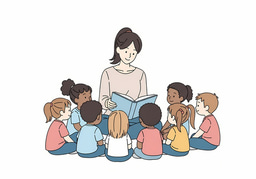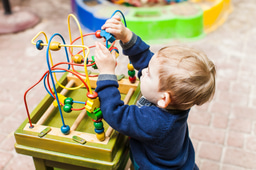Supporting children’s health and wellbeing over the summer: Sun safety

Introduction
The UK weather is often unpredictable and can change with little notice. Babies, young children and children with SEND are more susceptible to hot weather conditions and will have much less tolerance levels to heat. Therefore, it is important to be able to respond to the changing weather and ensure that children can enjoy it safely. The aim of this article is to provide you with some key information and suggestions of what you can do to keep babies and young children safe during the summer months.
The information within this article is more generally aimed at babies and young children. However, you may be caring for children with specific health conditions, so it is important to know what specific needs they have and put extra precautions in place as needed. In cases where children have complex health conditions, you should always seek advice from their health care professionals and ensure a robust plan is in place outlining any specific procedures for all staff to follow.
This article will begin with covering some of the basics of sun safety, before moving on to some activities and resources that can be implemented within your own practice.
Sunscreen
A must have in hot/sunny weather is sunscreen. Sunscreen protects your skin from harmful UV rays and can prevent sun damage, which can increase the risk of skin cancer in later life. Therefore, while babies and young children are in your care, sunscreen is a vital part of ensuring sun safety practices.
As an early years provider, you should have a setting policy in place regarding the use and application of sunscreen. As a setting you need to decide if you are providing your own sunscreen or requesting that parents supply their own. If you are providing your own sunscreen, check all children for any potential allergies or skin sensitivity. Parental consent should also be obtained to enable you to apply/reapply sunscreen throughout the day. Where possible, it is also good practice to document when each child has had sunscreen applied and by who to ensure that every child has had sunscreen applied (it can get a bit confusing when you have large groups of children, particularly if they start at different times).
Any sunscreen, regardless of whether you are providing it as a setting or if the parents are bringing it in for their child, should be a minimum of 30 SPF and have a UVA rating of 4 or more stars. Current guidance from the NHS suggests that sunscreen should be applied 20 minutes before going outside and reapplied every two hours (even if it is cloudy) and after water play/swimming. Sunscreen can come in different forms such as creams, lotions and sprays. Some children do not like the feel of creams or lotions on their skin and a spray may be more suitable for them as it has a lighter feel. Speak with each child’s parents to find out what they use at home and if their child has a preference.
Create shade
Spending time in the shade is a great way to keep cool and avoid direct sunlight. You may already have some naturally shaded areas in your outdoor area created by trees or buildings. However, you may also need to create some additional shaded areas, such as by placing parasols or awnings over activities/resources outside such as sand and water trays. You could also add some tents outside that children can sit in and look at books or play with small world toys.
DO NOT COVER PUSHCHARS OR CAR SEATS WITH BLANKETS!!!
Although placing a blanket/sheet over a pushchair or car seat seems like a simple solution to keeping babies shaded, especially when out and about, it is actually a very dangerous practice. Covering a pushchair or car seat with a blanket or sheet can create a heat trap and reduce air circulation, causing the heat around a baby to rise significantly. This can quickly lead to overheating and heatstroke, which in babies and young children is a medical emergency. Additionally, covering a baby in a pushchair or car seat can reduce your visibility and you may not notice that they have been sick or are distressed as readily as having them in full view. Alternatively, use clip-on parasols and always position babies out of direct sunlight and place them in the shade.
It is good practice to familiarize yourself with the signs to look out for and the actions you should take with heat exhaustion and heatstroke. A good source of knowledge is the NHS website: Heat exhaustion and heatstroke - NHS
Dress for the weather:
When the weather is cold and wet, you dress appropriately such as putting on a coat and wellington boots. The same principle applies for hot weather; you should ensure that babies and young children are dressed appropriately. Encourage parents to dress their babies and children in loose-fitting, lightweight clothes which cover as much skin as possible. All babies and young children should also wear a hat to protect their head, neck and face from the sun. Although I have worked with babies and young children (and have children of my own) so I know the wearing of hats can be a particular challenge for some children and they will constantly take it off or even refuse to have it placed on their head. This can be frustrating for us as practitioners as we know they are an essential part of keeping children safe in the sun. Try and be consistent with encouraging them to wear a hat and role model by wearing your own. You could use visual aids to communicate that it is time to wear their hat and allow them to take it off again when they are inside.
Keeping children hydrated
In warmer weather, children need to be kept hydrated and may need extra encouragement to drink plenty of water. Ensure that you have a jug of fresh water and cups readily available for children to help themselves to throughout the day. However, even if children are independent in being able to access their own drinks, ensure that you use opportunities such as at snack and lunch times to provide every child with a drink, as not all children will access the water if they are engrossed in play.
For children who are not yet independent in being able to access their own drinks, take responsibility for giving them drinks regularly either through a bottle or their own cups throughout the day. A good practice tip to ensure children are getting plenty of opportunities to have a drink is to remember that every time you need a drink, offer all the children a drink too.
As mentioned in the introduction of this article, children with complex medical needs may require changes to their daily care plan during hot weather. For example, children who are tube fed may need extra water flushes throughout the day to ensure that they are kept hydrated. Therefore, always consult with their parents and healthcare teams and make any changes as required.
Another great way to hydrate children is by providing some ice lollies. As a setting you could make your own by adding some sugar free cordial or pure fruit juices to some water and freezing them in a mould. You could also offer the children some cooling snacks such as watermelon and cucumber sticks that have been kept in the fridge.
Rest time
Hot weather can make babies, and young children exert more energy as their bodies are working hard to keep them cool and subsequently, they can seem more tired than usual. In hot weather you should set up more quiet, cosy spaces where children can rest and relax freely. These spaces should be set up both indoors and outside and be shaded. In addition to having readily available spaces for children to access, it is good practice to schedule in periods of rest throughout the day. Not all children will recognize when they need to rest, especially if they are happily engaged in activities. In the UK, the sun is the hottest between 11am and 3pm, with the strongest sun radiation being around midday. Although it is not practical, or advisable to keep children inside all day, you should be aware of these times and use your judgement if you think that it is too hot for the children to be outside. During these times, however, you should always schedule some time when all the children have an opportunity to rest and relax in the shade (either inside or outside), where they can sit or lie down to rest and recharge. These times can be used for quieter/slower activities such as story time with an ice lolly, or mark making on large pieces of paper on the floor while listening to some classical music.
If a baby or young child naps during the day, make sure they are in a well-ventilated area and ensure you check on them more frequently than usual to ensure they are not overheating. You may consider removing some layers of their clothing before you place them down to sleep, which will aid in keeping them cool and safe while sleeping.
Children’s behaviour and hot weather
As adults we can get hot, bothered and irritable in hot weather, even though we are well practiced in being able to self-regulate. For children, they can also become irritable and more emotional during periods of hot weather and may need more support in being able to co/self-regulate. As I always state, children’s behaviour is a form of communication, and they are trying to tell you something (even if they do not know what that something is themselves). Be mindful that the weather can affect how a child is feeling and subsequently how they behave. If you notice that a child is unsettled, it could be that they are too hot, respond to this by trying to cool them down and provide a space for them to be able to rest and co-regulate with you.
Activities to keep children cool
Children should have access to activities and resources, both indoors and outside. If children are outside, ensure that they are under shade and out of direct sunlight when engaging in activities. During hot weather, water play is a brilliant activity to help children keep cool. Water play can range from having water in a tray on a table, to having a small paddling pool outside that children can sit in and walk through. If you are using a paddling pool, ensure that all children are directly supervised at all times. You may have access to a garden hose where children can play with water from it and make puddles to play in (check out your local councils for any hose pipe bans that maybe in place). You may also have a water/splash park in your local area where you can take the children on a trip to cool down (with parental consent and the relevant risk assessments already in place).
Ice is another great resource to add to water play or as a stand-alone activity. You could add ice cubes to the water play. You can extend this by freezing natural objects in the ice cubes such as flowers and leaves so the children can see what happens when the ice melts. Additionally, you can do this on a larger scale where you freeze toys in ice and the children have to try and melt the ice to get to the toy.
During hot weather, it is a good idea to try and replace more physical activities with slower, less strenuous ones. So instead of running, you could ask the children to see if they could move in different ways such as on their tiptoes or crawling. Provide lots of opportunities for mark making and small world play which children can do sitting or lying down.
Conclusion
The hot, sunny weather can make us all feel better and encourage us to spend more time outside, which is great for our health and overall wellbeing. However, the sun needs to be enjoyed in a way that is safe and protects us from any potential harm. Babies, young children and children with SEND can be more vulnerable to the effects of hot weather. As early years practitioners we have a duty of care and a statutory responsibility to keep children safe. This article provided you with some key information and good practice tips on how to support children and keep them safe during periods of hot weather.
As well as following NHS guidance and your own settings policies and procedures, you should also use your own professional judgment and respond to the individual needs of the children in your care. Although it may not be adversely hot outside, you may decide to keep the children inside as it may be too hot for them. You may have an activity planned but recognize that the children are too hot and bothered to engage in so you may push that activity aside in favour of having a story and an opportunity for them to rest and cool down. The weather in the UK can be unpredictable and the hot weather can be fleeting at times, so make the most of it and have fun!





Please sign in or register for FREE
If you are a registered user on SEND Network, please sign in